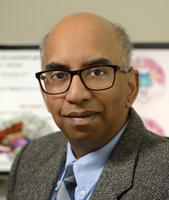Computational Anatomy
- Multiresolution registration of histological and magnetic resonance images. At the microscopic scale, anatomical boundaries can be well defined. Diffeomorphisms is the only way whereby these cytoarchitectonic boundaries can be transferred to macroscopic coordinates. Thus we wll be in a good position to correlate MR morphometrics and stereological data from histology.
- Dosimetry for whole body pediatric CT scans. Concerns about overuse of CT in pediatric imaging have been raised because of the amount of radiation applied. Diffeomorphisms will allow acurate calculation of size of organs (stomach, heart, lungs, etc.) in the child.
- Cortical thickness variability. It appears that functionally defined cortical regions such as the planum temporale which is part of the superior temporal gyrus adjacent to the auditory cortex exhibits variation in thickness from the Heschl's sulcus towards the lateral aspect of the STG. This may explain the heteromodal function of the PT in speech and language processing.
- Smoothing triangulated surfaces. Smoother surfaces are more amenable to morphometric analysis. A first step is to apply diffeomorphism in the ambient space encompassing the triangulated surface via mean curvature flow or Willmore flow. The latter is preferable but more challenging.
- Alternating Kernel Mixture (AKM) segmentation. Automated segmentation of biomedical images is a major challenge. In the absence of a "gold standard", manual segmentation by a knowledgeable neuroanatomist should be the basis for comparison with automated segmentation methods. In this respect, AKM is able to reflect the variability by human raters. This can be exploited to generate anatomically consistent segmentation.
- Euler-Poincaré Equation. Analogies with classical mechanics enable us to apply established and proven computational methods to generate accurate solutions of EPDiff required for shape analysis of biomedical structures. See movies.
- Diffeomorphic Active Contours. We have developed an EPDiff based gradient descent segmentation algorithm that uses AKM and control points to preserve topology.See movies.
